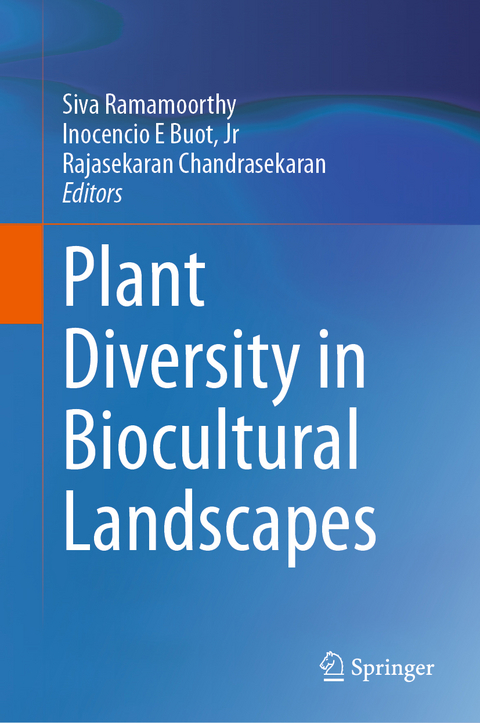
Plant Diversity in Biocultural Landscapes
Springer Verlag, Singapore
978-981-19-8648-2 (ISBN)
Dr. Siva Ramamoorthy Dr. Siva Ramamoorthy is Professor and Dean, School of Bio Sciences and Technology, VIT University, India. He obtained his undergraduate and postgraduate degrees in Plant Science from Madurai Kamaraj University. He did his Ph.D. in “Plant Genetic diversity” from Bharathidasan University and postdoctoral research at Ben Gurion University and Gyeongsang National University. His research interests are Plant Biotechnology and Pigments Biology publishing more than 155 manuscripts in peer reviewed journals with high impact factor and received many recognitions. Past three years Dr. Siva has been recognized as one among the Top 2% scientists of the world per Standford University and Mendeley survey. He is also the associate editor of many reputed journals. Dr Inocencio E Buot Jr Dr Inocencio E Buot Jr is professor of botany, curator of the Plant Biology Division Herbarium and head, Plant Systematics Laboratory, Institute of Biological Sciences, a Center of Excellence for Biology since 1984, University of the Philippines Los Baños. He obtained his PhD (Ecology) from Chiba University and his postdoctoral certificate in Landscape Ecology from the Ministry of Forestry in Kyoto through the auspices of the Japan Society for the Promotion of Science. His laboratory is now focusing on biodiversity conservation and plant systematic studies. He collaboratively published more than 200 articles in indexed journals and got numerous academic awards. Dr. Rajasekaran Chandrasekaran Dr. Rajasekaran Chandrasekaran is professor at the Department of Biotechnology, Vellore Institute of Technology. He is graduated in Botany at the University of Madras and Annamalai University. He specialized on plant ecophysiology in his doctoral degree at H.N. B. Grahwal University. For twenty-seven years, his laboratory is focusing on ecophysiology, conservation biodiversity, bioprospecting of medicinal and aromatic plants, phycoremediation and climate change indicators. He has more than 100 publications in form of journal articles and books. For his impactful works, Dr. Chandrasekaran has been recognized as Fellow of the Royal Soc of Biology, Linnean Society of London, Indian Society for Plant Physiology, Academy of Sciences Chennai, Academy of Biological Sciences among others. He is commission member of many theme groups of IUCN also recipient of many awards.
Part 1. Biocultural Landscapes During the Anthropocene.- Chapter 1. Understanding Plant Diversity Dynamics in Biocultural Landscapes During The Anthropocene.- Chapter 2. Building Sustainability in Community-Managed Mangrove Forest using Biocultural Approach to Conservation.- Chapter 3. Plant Diversity in Biocultural landscapes during Anthropocene: The Need For Conservation, Challenges, and Future Prospects in Today’s World.- Chapter 4. Extinction of Medicinal Plants in Anthropocene Epoch: Special Reference to Rauwolfia Serpentina.- Part 2. Keystone and Other Significant Species in Bicultural Landscapes.- Chapter 5. Ethnobotany of Yams (Dioscoreaceae) Used by Local Communities in the Northwest of Luzon Island.- Chapter 6. A Preliminary Survey of The Genus Hoya R.Br. (Apocynaceae) in Papua, Indonesia with Notes on Hoya as Larval Food plant of Euploea netscheri Snellen.- Chapter 7. Species Diversity and Habitat Association of Ferns and Lycophytes in Mts. Palay-Palay Mataas na Gulod Protected Landscape.- Chapter 8. Remaining Subpopulations of Impatiens Manillensis Walp. 1843 (Balsaminaceae) In Mts. Palay-Palay-Mataas-Na-Gulod Protected Landscape, Luzon Island, Philippines.- Chapter 9. Pteridophytes in Mount Matutum Protected Landscape.- Chapter 10. Morphological Diversity of Kopyor Coconut in Indonesia.- Chapter 11. Ecology of Understory Plants of Forests over Limestone in Samar Island, Philippines.- Chapter 12. Taxo-ethnobotany of Genus Ficus l. In Jammu and Kashmir State (India).- Part 3. Ecosystem Prcesses in Bicultural Landscapes.- Chapter 13. Food to Medicine: The Impact of Soil and Climatic Factors on the Phytochemical Property of Anahaw (Saribus rotundifolius (Lam.) Blume Shoot.- Chapter 14. Floral and Fruiting Phenology in the Lowland Forests of Palanan, Isabela, Philippines.- Chapter 15. A Survey of Understory Vegetation in the Biocultural Landscape of Mount Makiling, Luzon Island, Philippines: Implications for Sustainable Management.- Chapter 16. Floral Diversity and Carbon Stock Assessments of Montane Forests Along the Tri-Boundaries of Benguet, Ifugao and Mountain Province, Philippines.- Chapter 17. The Dynamics of Soil Microbiome Upon Anthropogenic Changes In Plant Diversity and Land Management Practices.- Chapter 18. Plants' anatomical and genetic responses to anthropogenic climate change and human-induced activities.- Chapter 19. Impact of Anthropogenic compounds on biodiversity: A comprehensive analysis.- Part 4. Best Practices in Plant Diversity Conservation.- Chapter 20. Documentation of the Phenocalendar of Allaeanthus luzonicus (Blanco) Fern.-Vill. (Family Moraceae) to Sustain Its Utilization .- Chapter 21. Analyzing the Spatio-Temporal Changes of the Biocultural Landscape of Banaue, Philippines Using GIS.- Chapter 22. Plant Diversity in Selected Agro- and Forest Ecosystems in Indigenous Cultural Communities (ICCs) in the Cordillera Region, Northern Philippines.- Chapter 23. The Stories of Organic Farming Champions in the Philippines and their Crop Diversity Practices.- Chapter 24. Current status of Seaweed diversity: Anthropogenic interventions.- Part 5. Emerging Frameworks for Conservation.- Chapter 25. Homegarden Agroforestry for Plant Diversity Conservation in an Urban Landscape: Practices and Prospects.- Chapter 26. Comprehending the cultural landscape of Mount Makiling: a road to Community Wellbeing necessary to enhance ecosystem integrity.- Chapter 27. System Dynamic Modelling of Top Harvested Plant Bioresources in Northern Negros Natural Park.- Chapter 28. Heritage Negotiations in Manila and Pampanga: The Use of Toponyms in the Study of Two Biocultural Landscapes in the Philippines.- Chapter 29. Liaforestry-sustainable Forest Management Model Using Multi-Purposes Tree Species for Reforestation and Climate Change Mitigation, Lesson Learned from Meru Betiri National Park.- Chapter 30. Conservation of IUCN Threatened Zingiberaceae Species in Tropical Asia:Challenges, Gaps and Opportunities.
| Erscheinungsdatum | 06.07.2023 |
|---|---|
| Zusatzinfo | 1 Illustrations, black and white; IX, 724 p. 1 illus. |
| Verlagsort | Singapore |
| Sprache | englisch |
| Maße | 155 x 235 mm |
| Themenwelt | Naturwissenschaften ► Biologie ► Ökologie / Naturschutz |
| Naturwissenschaften ► Biologie ► Zoologie | |
| Naturwissenschaften ► Geowissenschaften ► Geografie / Kartografie | |
| ISBN-10 | 981-19-8648-7 / 9811986487 |
| ISBN-13 | 978-981-19-8648-2 / 9789811986482 |
| Zustand | Neuware |
| Haben Sie eine Frage zum Produkt? |
aus dem Bereich


